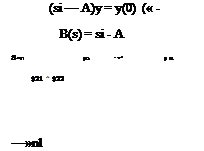AUTONOMOUS LINEAR/INVARJANT SYSTEMS
The general equation for linear/invariant systems is (3.2,20). When the system is autonomous and hence has zero input it reduces to
У = Ay (3.3,1)
When the initial state vector is y(0), the Laplace transform of (3.3,1) is
 |
||
sy = Ay + y(0)
in which atj are the elements of A. В is called the characteristic matrix of the system. Equation (3.3,2) then becomes
|
B(s)y = y(0) |
||
|
whence |
у = B-!(s)y(0) |
(3.3,4) |
|
where |
B-i-adiB |B| |
(3.3,5) |
By virtue of the definition of the adjoint matrix (ref. 2.1) it is evident that the elements of adj В and of |B| are polynomials in s. |B| is called the characteristic determinant, and its expansion
|B| =/(e) (3.3,6)
is the characteristic polynomial. It is evident from (3.3,3) that /(s) is of the
nth degree. Hence
f(s) = sn + cn_1sn~’1 H——– c0
= (s – ^)(s -*,)•••(«- K) (3.3,7)
where • ).n are the roots of /(s) = 0, the characteristic equation. We now rewrite (3.3,4) as
l(s) = ~^-У(0) (3-3,8)
f(s)
The inversion theorem (2.5,6) can be applied to (3.3,8) for each element of y, and the column of these inverses is the inverse of y(s), i. e.
![]() УV) = I P B(S)) y(0)eA,<
УV) = I P B(S)) y(0)eA,<
r=l l f(s) }s=xr
We now define the vector
and hence can write the general solution of (3.3,1) that satisfies the initial conditions as
. У« = І>е^ (3.3,10)
r~ 1
n
It follows that y(0) = 2 Уr Note also that by setting t = 0 in (3.3,9) the
r=l
summation therein is shown to be equal to the identity matrix I.
COMPACT FORM OF SOLUTION
A more compact form of the solution is available. Define the exponential function of a matrix M by an infinite series (like the ordinary exponential of a scalar), i. e.f
![]() eM=I + M + – M2 + — –
eM=I + M + – M2 + — –
2!
 |
||
It is evident then that
is a solution of (3.3,1) that has the initial value y(0).











